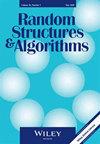秩树子网络中模式的极限定理
IF 0.8
3区 数学
Q4 COMPUTER SCIENCE, SOFTWARE ENGINEERING
引用次数: 1
摘要
我们证明了随机均匀选取的有序树子网络边缘模式出现次数的极限规律。我们的结果扩展了Bienvenu等人(2022)证明的樱桃极限定律。对于高度$1$和$2$的模式,我们表明它们要么频繁发生(平均值是渐近线性的,极限律是正态的),要么零星发生(平均值是渐近常数的,极限律是泊松的),要么不是全部发生(平均值趋于$0$,极限律是退化的)。我们期望这些是任何条纹图案的唯一可能的极限定律。本文章由计算机程序翻译,如有差异,请以英文原文为准。
Limit theorems for patterns in ranked tree‐child networks
We prove limit laws for the number of occurrences of a pattern on the fringe of a ranked tree-child network which is picked uniformly at random. Our results extend the limit law for cherries proved by Bienvenu et al. (2022). For patterns of height $1$ and $2$, we show that they either occur frequently (mean is asymptotically linear and limit law is normal) or sporadically (mean is asymptotically constant and limit law is Poisson) or not all (mean tends to $0$ and limit law is degenerate). We expect that these are the only possible limit laws for any fringe pattern.
求助全文
通过发布文献求助,成功后即可免费获取论文全文。
去求助
来源期刊

Random Structures & Algorithms
数学-计算机:软件工程
CiteScore
2.50
自引率
10.00%
发文量
56
审稿时长
>12 weeks
期刊介绍:
It is the aim of this journal to meet two main objectives: to cover the latest research on discrete random structures, and to present applications of such research to problems in combinatorics and computer science. The goal is to provide a natural home for a significant body of current research, and a useful forum for ideas on future studies in randomness.
Results concerning random graphs, hypergraphs, matroids, trees, mappings, permutations, matrices, sets and orders, as well as stochastic graph processes and networks are presented with particular emphasis on the use of probabilistic methods in combinatorics as developed by Paul Erdõs. The journal focuses on probabilistic algorithms, average case analysis of deterministic algorithms, and applications of probabilistic methods to cryptography, data structures, searching and sorting. The journal also devotes space to such areas of probability theory as percolation, random walks and combinatorial aspects of probability.
 求助内容:
求助内容: 应助结果提醒方式:
应助结果提醒方式:


